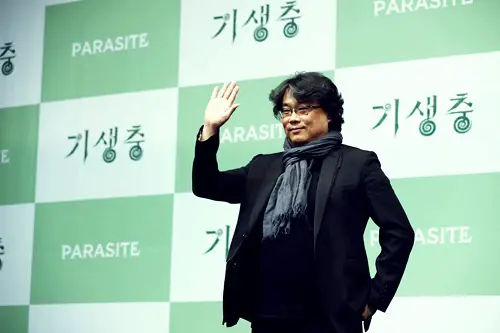
“Parasite” is a South Korean dark satire spine chiller movie coordinated by Bong Joon-ho, which has gathered worldwide recognition for its multifaceted narrating, complex subjects, and realistic greatness. The film won four Foundation Grants, including Best Picture, impacting the world forever as the main non-English language film to win the honor. The following are ten less popular realities about “Parasite” that uncover its profundity, the chief’s vision, and the complexities behind its creation.
Extraordinary Sort Mix
“Parisite” challenges customary sort characterizations. Chief Bong Joon-ho alludes to it as a “drama,” recognizing its mix of components from shows, thrill rides, and comedies. This class twisting methodology adds to the film’s extraordinary tone and has been critical in its widespread allure.
Compositional Importance
The engineering in “Parasite” isn’t simply a background yet a person in itself. Both the rich Park family’s home and the Kim family’s semi-cellar condo were fastidiously planned sets, worked without any preparation to mirror the characters’ societal position and the film’s subjects of class battle and disparity.
Morse Code Messages

Morse code is a key plot component in “Parasite,” utilized by the fortification bound character to send messages. This incorporation isn’t just an imaginative plot gadget yet additionally an impression of chief Bong’s tender loving care. It is accounted for that the Morse code messages are exact and can be decoded by watchers who comprehend Morse code.
The Researcher’s Stone
The Researcher’s Stone highlighted in the film represents abundance and realism. It is skilled to the Kim family as a symbolic that should bring them riches. Strangely, the stone is a focal theme all through the film, epitomizing the topics of yearning and the heaviness of material cravings.
Peach Sensitivity Plotline

The peach sensitivity is presented right off the bat when Kim Ki-charm, an individual from the Kim family, finds that the child of the well off Park family, Park Da-tune, has an extreme aversion to peaches. This apparently harmless detail gets rolling a chain of occasions that further hazy spots the lines among truth and fiction.
The peach sensitivity turns into an impetus for the Kims’ control of the Parks. By taking advantage of this weakness, the Kims compose an arrangement to invade the Recreation area family deceptively, involving their insight into the sensitivity to situate themselves as crucial representatives. This plotline highlights the film’s investigation of how people exploit shortcomings and weaknesses to acquire a benefit in a general public set apart by friendly disparity.
As the story unfurls, the peach sensitivity takes on a figurative importance. It addresses the delicacy of the Parks’ ideal exterior and the innate flightiness of their apparently unspoiled lives. The sensitivity fills in as a figurative sign of stowed away weaknesses and unexpected outcomes that disturb the painstakingly built picture of riches and achievement. It likewise features the delicacy of the connections and power elements inside the film, with the Kims taking advantage of the Parks’ weakness for their own benefit.
Moreover, the peach sensitivity plotline fills in as a critique on friendly separation and the lengths people will go to ascend the social stepping stool. The Kims’ control of the peach sensitivity features the frantic measures they take to work on their social standing, regardless of whether it implies deluding others and taking advantage of their shortcomings. It highlights the film’s assessment of the ethical vagueness that emerges when people are headed to atrocities by cultural tensions and the quest for up portability.
Besides, the peach sensitivity plotline adds to the film’s fundamental pressure and anticipation. As the crowd becomes mindful of the sensitivity, there is a steady feeling of looming catastrophe. Each cooperation including peaches becomes loaded with pressure, producing a degree of vulnerability and disquiet. This uplifted pressure supports the film’s investigation of the sensitive harmony among truth and trickiness, reflecting the dubious idea of the characters’ connections and their delicate traction in the realm of the well off.
All in all, the peach sensitivity plotline in “Parasite” fills in as a cunning story gadget that upgrades the film’s subjects of double dealing, control, and the unusualness of human cooperations. It represents the delicacy of the Recreation area family’s veneer, highlights the ethical equivocalness of the characters’ activities, and creates strain and anticipation all through the film. The peach sensitivity plotline adds profundity to the story and adds to the intricate trap of connections and power elements that characterize “Parasite” as a provocative investigation of social disparity.
Bong Joon-ho’s Definite Storyboards
Bong Joon-ho’s careful and itemized storyboards assumed a pivotal part in the formation of “Parasite,” adding to the film’s visual soundness and story accuracy. Known for his careful way to deal with filmmaking, Bong worked intimately with his creation group to fastidiously design and envision each shot, bringing about a consistent and outwardly enamoring film.
The storyboards for “Parasite” permitted Bong Joon-ho to create the film’s visual language and sythesis carefully. By drawing out each scene, he had the option to try different things with various camera points, obstructing, and outlining decisions. This degree of pre-arranging empowered him to successfully impart his vision to the creation group, guaranteeing that everybody engaged with the filmmaking system had an unmistakable comprehension of the ideal tasteful and story objectives.
The definite storyboards additionally worked with proficient coordination between different divisions, for example, cinematography, creation plan, and outfit plan. Bong’s visual portrayals gave a diagram to the whole team, permitting them to work together agreeably and pursue a brought together vision. This degree of coordination was especially pivotal in “Parasite,” given the film’s many-sided set plans, differentiating conditions, and the need to keep up with visual consistency all through.
Moreover, the storyboards assisted Bong Joon-ho with settling on exact and think narrating decisions. He carefully arranged the pacing, timing, and beat of every scene, guaranteeing that the visual and account components worked as one to make strain, tension, and close to home effect. The storyboards permitted him to explore different avenues regarding various arrangements and structures, refining the narrating system and upgrading the in general true to life experience.
Besides, Bong’s storyboards given a visual reference to the entertainers, assisting them with figuring out the expected impeding, signals, and cooperations inside every scene. This degree of clearness upheld the exhibitions and permitted the entertainers to encapsulate their characters inside the carefully planned visual system completely.
The meticulousness in Bong Joon-ho’s storyboards is clear in the end result of “Parasite.” The film’s painstakingly created shots, the utilization of visual themes, and the consistent changes between differentiating conditions are a demonstration of the care and accuracy that went into the pre-creation arranging. The storyboards filled in as a directing guide, permitting Bong to rejuvenate his creative vision in an outwardly dazzling and narratively strong way.
All in all, Bong Joon-ho’s itemized storyboards were instrumental in the making of “Parasite.” They gave a visual plan to the film, empowering exact coordination among divisions and working with a bound together vision. The storyboards permitted Bong to settle on purposeful narrating decisions, upgrade the exhibitions, and keep up with visual consistency all through the film. The careful preparation and scrupulousness exhibited in the storyboards assumed a critical part in the visual cognizance and story accuracy that characterize “Parasite” as a realistic work of art.
Natural Subtexts
One of the ecological subtexts in “Parasite” is the unmistakable difference between the day to day environments of the affluent Park family and the devastated Kim family. The Parks live in a lavish, structurally staggering home encompassed by rich plant life and a carefully kept up with garden. Conversely, the Kims live in a confined cellar condo, scarcely presented to regular light or green spaces. This juxtaposition fills in as a visual portrayal of the inconsistent dispersion of assets and the ecological variations coming about because of financial divisions.
Besides, the film depicts the Parks’ separation from the normal world. The family frequently stays bound to their rich home, secluded from the outer climate. Their way of life is described by phony and separation from the regular world, representing a disengagement from the biological outcomes of their activities. Conversely, the Kims, because of their financial conditions, are more presented to the brutal real factors of the climate and are portrayed drawing in with the regular world in their battle for endurance.
One more part of the ecological subtext in “Parasite” is the presence of weighty downpour and flooding all through the film. Downpour and flooding act as similitudes for the disturbance and commotion brought about by financial disparity. In any case, they can likewise be deciphered as a portrayal of the ecological results of human activities. The unrelenting precipitation mirrors the eccentricism and horrendous force of nature, proposing that the negligence for civil rights and the abuse of assets will ultimately prompt devastating outcomes.
The film additionally quietly suggests ecological debasement through its portrayal of the monetary inconsistencies and the quest for material riches. The Parks’ extravagant way of life, described by exorbitant utilization and inefficiency, stands out from the creativity and thriftiness of the Kims. This difference recommends that unrestrained industrialism and a dismissal for reasonable practices add to ecological debasement and enlarge the hole between those who are well off and the less wealthy.
All in all, “Parasite” consolidates natural subtexts that add profundity to its social critique. The film features the inconsistent dissemination of assets and the ecological inconsistencies coming about because of financial divisions. It represents the unit of the affluent from the normal world and highlights the outcomes of impractical practices and the quest for material riches. Through its visual narrating and inconspicuous allegories, “Parasite” prompts watchers to consider the ecological effects of human activities and the pressing requirement for additional evenhanded and feasible social orders.
The Title’s Various Implications
At its generally prompt level, “Parasite” alludes to the Kim family’s penetration of the well off Park family’s lives. The Kims decisively position themselves as workers, bit by bit exploiting the Parks’ assets, home, and trust for their own advantage. They figuratively connect themselves to the Parks, taking care of off their riches and honor in a parasitic way. The film investigates the intricacies and moral ambiguities that emerge as the Kims exploit the Parks while at the same time longing for a superior life.
Past the singular characters, “Parasite” stretches out its similitude to study the more extensive social designs that sustain disparity. The film depicts a general public where the rich and strong stay unaware of the battles and difficulties looked by the oppressed. The parasitic connection between the Kims and the Parks turns into an impression of the shifty idea of class divisions, where the well off feed off the work and subjugation of the distraught without completely recognizing their reality or conditions.
Also, “Parasite” prompts watchers to consider the manners by which cultural frameworks make and support parasitic connections. The film questions the reasonableness of a general public where up portability is restricted, and the underestimated are left with no decision except for to depend on the special for endurance. It features the recurrent idea of neediness and the troubles looked by those endeavoring to break liberated from their minimized positions, at last recommending that the parasitic connection between the rich and the poor is an innate result of the current social designs.
Moreover, the title “Parasite” welcomes thought of the moral and moral ramifications of endurance and desire inside the setting of a parasitic relationship. As the film unfurls, it moves watchers to scrutinize the lengths people will go to advance their conditions, obscuring the limits among good and bad in our current reality where everybody is competing for their own endurance and flourishing.
All in all, the title “Parasite” in Bong Joon-ho’s film envelops different layers of importance. It addresses the invasion and abuse of the rich by the ruined Kim family, while additionally representing the more extensive social designs that sustain imbalance. It prompts reflection on the ethical ramifications of endurance and desire inside a parasitic relationship and brings up issues about the decency of a general public that powers people into such elements. “Parasite” fills in as a strong similitude that typifies the complicated transaction between the characters, the social frameworks, and the more extensive critique on society’s power elements and class battles.
The Film’s Language and Social Reach
One reason for the film’s broad allure is its wonderful narrating and drawing in account. “Parasite” winds around an enrapturing story of social imbalance and class battle, introducing characters that are complicated and engaging. The film’s investigation of subjects like desire, relational intricacies, and the quest for a superior life evokes an emotional response from watchers no matter what their social foundation. The story unfurls such that keeps crowds as eager and anxious as ever, making a feeling of tension and interest that rises above language obstructions.
Another component adding to the film’s worldwide reach is its careful craftsmanship and scrupulousness. The cinematography, creation plan, and exhibitions in “Parasite” are generally lauded for their greatness. The visual language of the film actually passes on feelings, lays out environments, and conveys key messages. The scrupulousness in portraying the differentiating conditions of the well off Park family and the ruined Kim family adds lavishness and profundity to the narrating, making it available and convincing for crowds around the world.
Moreover, “Parasite” investigates topics that are significant and full in social orders past South Korea. The assessment of social disparity, the intricacies of human connections, and the quest for up versatility are general subjects that rise above social limits. The film’s depiction of the battles looked by minimized people and the moral predicaments emerging from their endeavors to advance their conditions hits home for crowds from assorted social foundations who can connect with comparative cultural difficulties in their own unique circumstances.
The basic and business outcome of “Parasite” likewise owes a lot to the film’s global acknowledgment and dissemination. Winning the Palme d’Or at the Cannes Film Celebration and getting various honors and designations from renowned honor services helped raise its profile and contact a more extensive crowd. The film’s circulation in different nations and its accessibility with captions or naming permitted watchers all over the planet to encounter its narrating firsthand.
All in all, “Parasite” epitomizes the capacity of a film to rise above language and social obstructions through its convincing narrating, fastidious craftsmanship, and widespread subjects. The film’s investigation of social disparity, human connections, and the quest for a superior life resounds with crowds around the world. By introducing interesting characters and utilizing strong visual narrating methods, “Parasite” charms watchers from different social foundations and supports significant conversations about the all inclusive parts of the human experience. The film’s worldwide acknowledgment and circulation further added to its worldwide reach, setting its status as a true to life magnum opus with a wide social effect.
A Topical Continuation
At its center, “Parasite” looks at the unmistakable variations between the affluent Park family and the devastated Kim family. The Kims, residing in a confined storm cellar loft and battling to earn enough to get by, end up in a position where they should penetrate the Recreation area family by acting like gifted specialists. Through their finesse and control, the Kims secure work inside the Recreation area family, taking advantage of their situations for individual increase.
The film depicts the parasitic connection between the two families as an illustration for the more extensive cultural separation. The Kims, addressing the underestimated and financially hindered, are compelled to depend on the riches and assets of the Parks to make due. They stick to the special way of life of the Parks, getting their food from them, similar as a parasite depends on a host for its endurance. In the mean time, the Parks stay careless in regards to the genuine personalities and battles of the Kims, propagating their own propensity for self-absorption and prevalence.
“Parasite” likewise dives into the ethical intricacies and moral quandaries that emerge from this parasitic relationship. As the Kims exploit the Parks for their own benefit, the film powers watchers to scrutinize the idea of endurance and the lengths people will go to advance their conditions. It presents a basic assessment of the frameworks and designs that sustain social imbalance and the intrinsic pressures that emerge from such inconsistencies.
Moreover, “Parasite” features the repeating idea of neediness and the difficulties looked by those caught in financial limitations. The Kim family’s endeavors to get away from their devastated conditions eventually lead to a deplorable result, uncovering the limits forced by cultural orders and the troubles of up portability. The film highlights the foundational obstructions that keep people and families from breaking liberated from their minimized positions, sustaining a pattern of parasitic reliance.
All in all, “Parasite” breathtakingly investigates the topics of social disparity, class battle, and the perplexing elements between the rich and poor people. Through its depiction of the cooperative yet parasitic connection between the Kim and Park families, the film reveals insight into the inconsistencies and pressures inside society. It incites watchers to basically analyze the ethical intricacies of endurance and the foundational obstructions that propagate social disparity. “Parasite” fills in as a significant discourse on the human condition, encouraging us to stand up to the real factors of our own social orders and the power elements that shape them.
These ten less popular realities about “Parasite” shed light on the layers of intricacy inside the film. From its type opposing story to its careful set plan, the unobtrusive discourse on natural issues, and the profundity of its social assessment, “Parasite” remains as a demonstration of Bong Joon-ho’s dominance as a producer and the force of film to reverberate across social limits. The film’s worldwide achievement isn’t just a victory for South Korean film however for global movies all in all, provoking crowds and producers the same to reevaluate the hindrances of language and the potential for general narrating.

